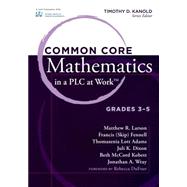Common Core Mathematics in a PLC at Work
, by Larson, Matthew R.; Fennell, Francis; Adams, Thomasenia Lott; Dixon, Juli K.; Kobett, Beth Mccord- ISBN: 9781936764006 | 1936764008
- Cover: Paperback
- Copyright: 4/12/2012
Traditional curriculum and teaching practices are antiquated, do not address the educational needs of students, and are inconsistent from district to district, school to school, and classroom to classroom. This inequity has caused many students to miss out on the opportunity to learn vital knowledge. Common Core Mathematics in a PLC at Work¿, Grades 3¿5 gives teachers the tools to effectively offer mathematics instruction and address the Common Core State Standards (CCSS) for mathematics challenge: All students successfully learning rigorous standards for college or career preparatory mathematics. Much of the material series editor Timothy D. Kanold and authors Matthew R. Larson, Francis (Skip) Fennell, Thomasenia Lott Adams, Juli K. Dixon, Beth McCord Kobett, and Jonathan A. Wray present in this book, and the Common Core Mathematics series, has been part of the national discussion on mathematics reform and improvement since the National Council of Teachers of Mathematics¿ (NCTM) release of the Curriculum and Evaluation Standards in 1989. This book provides a teacher-focused guide to teaching and learning mathematics in grades 3¿5. The five chapters focus on the five fundamental areas (collaboration, instruction, content, assessment, and intervention) required to prepare every teacher for successful implementation of CCSS for mathematics. Chapter 1 discusses the necessity to shift to collaborative teams within a PLC to successfully implement the CCSS for mathematics. Chapter 2 focuses on the CCSS Mathematical Practices, the high-cognitive-demand tasks necessary for procedural fluency and student understanding of the CCSS. Chapter 3 describes the CCSS content¿the standards, content standard clusters, and domains¿and the shift to less (fewer standards) and more (deeper rigor with understanding). Chapter 4 introduces the teaching-assessing-learning cycle and describes formative assessment practices and summative assessment instruments. Chapter 5 illustrates the required response to intervention model¿a process that requires students to participate in differentiated instruction or intervention. Each chapter¿s Extending My Understanding section has resources and tools 3¿5 teachers can use in collaborative teams to understand and reflect on chapter recommendations. Although the target audience is 3¿5 teachers and teacher leaders, who are subject to the Common Core State Standards, every 3¿5 educator can learn valuable information to optimize mathematics teaching and learning.






